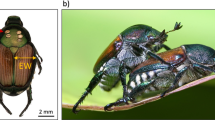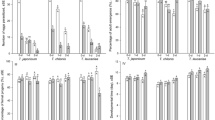Summary
Ovipositing females of the cynipid waspPseudeucoila bochei discriminate between parasitized and unparasitized hosts, which results in a far more uniform distribution of eggs over the hosts than would be obtained if oviposition were random (Fig. 1,a 0-f 0).
For the description of the distributions a few models were worked out, which rest on the assumption that the hosts are probed at random. The total number of effective probes made in a larva during the experiment is a random variable with a Poisson distribution and an expectation λ. The chance that at a certain probe an egg will be laid (δ) is dependent on the number of eggs present (j); 1=δ0<δ1≧δ2≧δ3.... In model I it was assumed that the female had only the ability to distinguish parasitized from unparasitized hosts. The chance that an egg will be laid in an unparasitized host when it is probed, δ0, is considered to be equal to 1, while δ1=δ2=...=δ n <1 (Fig. 2, 1,a 1-f 1). When the mean number of eggs present in a host was larger than about 1.1, this model did not describe the distribution of eggs satisfactorily (Fig. 3).
It seemed that the ovipositing female is not only able to distinguish parasitized from unparasitized hosts, but also to distinguish thenumber of eggs present in a host. In model II it was assumed that the wasp could distinguish between hosts with 0, 1, and 2 or more eggs: the chance that an egg would be laid in a host containing 2, 3, 4, ... eggs was, hence, the same in this model δ1<δ2=δ3=...=δ n (Fig. 2, 1,c 2,e 2,f 2). This model described the distributions of eggs much better (Figs. 4 and 5), but at mean numbers of eggs per host above 2 it was apparently inadequate.
Two other models were then tried, in which the chance δ that an egg would be laid in a host decreased with the number of eggs already present (j). In model III (Fig. 2) the chance decreased according to the function δ j =δ/j (δ0=1, δ<1). Fig. 1,d 3,e 3,f 3, gives some examples. In model IV the chance δ j =δj (δ0=1, δ<1) (see Fig. 1,d 4,e 4,f 4).
From the comparison of Figs. 6 and 7 it is clear that model IV gives the best description of the distributions of eggs found.
The value of these models is discussed, and plans for both an approach through experimental analysis and simulation models are given. In an Appendix the mathematical derivation of the models is presented.
Similar content being viewed by others
References
Assem, J. van den: Reproductive behaviour ofPseudeucoila bochei Weld (Hym., Cynip.). I. A description of courtship behaviour. Neth. J. Zool.19, 641–648 (1969).
Bakker, K.: An analysis of factors that determine success in competition for food among larvae ofDrosophila melanogaster. Arch. néerl. Zool.14, 200–281 (1961).
Bakker, K.: Host selection inPseudeucoila bochei. Proc. XII Int. Congr. Entom.1, 472 (1971).
Bakker, K., Bagchee, S. N., Zwet, W. R. van, Meelis, E.: Host discrimination inPseudeucoila bochei (Hymenoptera: Cynipidae). Ent. exp. & appl.10, 295–311 (1967).
Eijsackers, H. J. P., Bakker, K.: Elimination by physical attack of supernumerary larvae ofPseudeucoila bochei Weld (Cynipidae) in their hosts, larvae ofDrosophila. Neth. J. Zool.21, 205–207 (1971).
Eijsackers, H. J. P., Bakker, K.: Duration of the egg stage of the sexes inPseudeucoila bochei Weld (Cynipidae), a parasite ofDrosophila larvae. Neth. J. Zool.21, 166–171 (1971).
Eijsackers, H. J. P., Lenteren, J. C. van: Host choice and host discrimination inPseudeucoila bochei (Hym., Cynip.). Neth. J. Zool.20, 414 (1970).
Feller, W.: Introduction to probability theory and its applications, vol. I, 1962, xv and 461, and vol. II, 1966, xviii and 626. New York-London: John Wiley & Sons Inc. 1962, 1966.
Hadorn, E., Grassmann, A.:Drosophila undPseudeucoila. IV. Artspezifische Unterschiede in der Abwehrreaktion auf verschiedenen resistente Wespenstämme. 22. Jahresbericht d. Schweiz. Ges. f. Vererbungsforschung. Arch. Klaus-Stift. Vererb.-Forsch.37, 21–27 (1962).
Hadorn, E., Walker, I.:Drosophila undPseudeucoila. I. Selektionsversuche zur Steigerung der Abwehrreaktion des Wirtes gegen den Parasiten. Rev. suisse Zool.67, 216–225 (1960).
Jenni, W.: Beitrag zur Morphologie und Biologie der CynipidePseudeucoila bochei Weld, eines Larvenparasiten vonDrosophila melanogaster Meig. Acta zool.32, 177–254 (1951).
Meyer-Grassmann, A.:Drosophila undPseudeucoila. V. Beiträge zur Parasitierungsbiologie vonPseudeucoila bochei Weld (Cynipidae, Hymenoptera) und Bericht über zwei neue Mutanten. Rev. suisse Zool.74, 409–437 (1967).
Nappi, A. J., Streams, F. A.: Haemocytic reactions ofDrosophila melanogaster to the parasitesPseudeucoila mellipes andPseudeucoila bochei. J. Insect Physiol.15, 1551–1566 (1969).
Nappi, A. J., Streams, F. A.: Abortive development of the cynipid parasitePseudeucoila bochei (Hym.) in species of theDrosophila melanica group. Ann. entomol. Soc. Amer.63, 321–327 (1970).
Nöstvik, E.: A study ofPseudeucoila bochei Weld and its relationship toDrosophila melanogaster Meig. Genetica ed Entomologia2, 139–160 (1954).
Rao, C. R.: Linear statistical inference and its applications, xviii, 522 p. New York-London: John Wiley & Sons Inc. 1965.
Schlegel-Oprecht, E.: Versuche zur Auslösung von Mutationen bei der zoophagen CynipidePseudeucoila bochei Weld und Befunde über die stammspezifische Abwehrreaktion des WirtesDrosophila melanogaster. Z. indukt. Abstamm.-u. Vererb.-L.85, 246–281 (1953).
Streams, F. A.: Defense reactions ofDrosophila species (Diptera: Drosophilidae) to the parasitePseudeucoila bochei (Hymenoptera: Cynipidae). Ann. entomol. Soc. Amer.61, 158–164 (1968).
Streams, F. A., Greenberg, L.: Inhibition of the defense reaction ofDrosophila melanogaster parasitized simultaneously by the waspsPseudeucoila bochei andPseudeucoila mellipes. J. Invert. Path.13, 371–377 (1969).
Walker, I.: Die Abwehrreaktion des WirtesDrosophila melanogaster gegen die zoophage CynipidePseudeucoila bochei Weld. Rev. suisse Zool.66, 569–632 (1959).
Walker, I.:Drosophila undPseudeucoila. II. Schwierigkeiten beim Nachweis eines Selektionserfolges. Rev. suisse Zool.68, 252–263 (1961).
Walker, I.:Drosophila undPseudeucoila. III. Selektionsversuche zur Steigerung der Resistenz des Parasiten gegen die Abwehrreaktion des Wirtes. Rev. suisse Zool.69, 209–227 (1962).
Wilks, S. S.: Mathematical statistics, ix, 644 p. New York-London: John Wiley & Sons Inc. 1962.
Author information
Authors and Affiliations
Rights and permissions
About this article
Cite this article
Bakker, K., Eijsackers, H.J.P., van Lenteren, J.C. et al. Some models describing the distribution of eggs of the parasitePseudeucoila bochei (Hym., Cynip.) over its hosts, larvae ofDrosophila melanogaster . Oecologia 10, 29–57 (1972). https://doi.org/10.1007/BF00822760
Received:
Issue Date:
DOI: https://doi.org/10.1007/BF00822760




